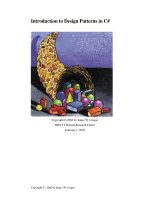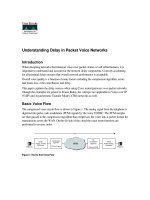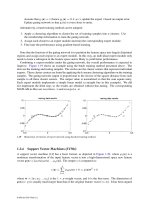Design template in cellular neural network
Bạn đang xem bản rút gọn của tài liệu. Xem và tải ngay bản đầy đủ của tài liệu tại đây (1.11 MB, 6 trang )
Vũ Đức Thái và Đtg
Tạp chí KHOA HỌC & CÔNG NGHỆ
116 (02): 3 - 8
DESIGN TEMPLATE IN CELLULAR NEURAL NETWORK
Vu Duc Thai1*, Sonxay Phanthavong2
1
College of Information and Communication Technology - TNU
Ha Noi-Vieng Chan Friendship Vocational School – PDR Lao
2
SUMMARY
Designing template is the most important stage for design and make CNN chip that gives
mathematical logic architecture basing on each problem. CNN researchers have many methods to
design template corresponding to solutions. This paper review some ways which is used
commonly in solving PDE using CNN. The paper has 3 parts, part 1 introduction CNN
technology; next part introduces some common ways to design template; part 3 give some
illustrations and the last is conclusion and future trends.
Keywords: Template Design, Partial Differential Equation, Cellular Neural Network, Lyapunov
Function, Taylor Expansion
INTRODUCTION*
The theory of CNN has been proposed by
L.O. Chua an L. Yang in 1988 and developed
to hardware architecture on CNN Universal
Machine (CNN-UM) by L.O. Chua and R.
Tamas [1,2]. The CNN is the physical
paralleled computing with array of processor
called cell. Depending on particular problem,
the numbers of cell can expand from 10,000
to 100,000 cells.
CNN is applied in many fields like image
processing; scientific computing; robot and
economic at high speed processing.
From 1988, many researchers have been
developed the CNN in theory and application
as prof the stability and condition constrains
for CNN chip.
The International Conferences of CNN
applicationare organized every two years. The
13th CNNA was organized from 29-31
August, at Turin, Italy with topics like:
Theoretical advances of CNNs; Sensory
integration; New spatial-temporal algorithms;
Biological relevance of CNNs; Applications
on FPGAs and GPUs;
Emerging new Cellular Wave Computing
Technologies.
In Vietnam, there are some groups in IT
Institute- Vietnam Academy of Science and
Technology; Hanoi National University;
*
Tel: 0985 158998, Email:
Hanoi Poly technique University and
especially in University of Information &
Communication Technology -Thai Nguyen
University (ICTU), the lecturers have taken
researches in image processing; Solving PDE;
CNN chaos in data encryption. Up to now,
they have had more than 10 papers on
Vietnamese and International scientific and
technology journals.
Cellular neural networks is made of a massive
aggregate of regularly spaced circuit clones,
called cells, which communicate with each
other directly only through its nearest
neighbors. Each cell is made of a linear
capacitor, a nonlinear voltage-controlled
current source, and a few resistive linear
circuit elements.
The basic circuit unit of a cellular neural
network is called a cell. It contains linear and
nonlinear circuit ele-ments, which typically
are
linear
capacitors,
linearresistors,
linearandnonlinear controlled sources, and
independent sources. The structure of cellular
neuralnetworksissimilar to that found in
cellular automata. Each cell in a cellular
neural network is connected only to its
neighbor cells. Adjacent cells can interact
direct with each other. Cells not directly
connected together may affect each other
indirectly because of the propagation effects of
the continuoustime dynamics of the network.
The state equation of cell C(i,j) is given by
the following equation:
3
Vũ Đức Thái và Đtg
C
xij
t
1
xij
R
Tạp chí KHOA HỌC & CÔNG NGHỆ
A(i, j; k , l ) ykl
116 (02): 3 - 8
B(i, j; k , l )ukl
C ( k ,l ) S r ( i , j )
zij
C ( k ,l ) S r ( i , j )
(1)
here, R, C is the linear resistor and capacitor respectively. A(i,j;kl) is the feedback operator
parameter; B(i,j;kl) is the control operator parameter and zij is the bias value of the cell C(i,j). On
the CNN system, (A, B, z) are the local connective weight values of each cell C(i,j) to its
neighbors.
vuij
vyij
vxij
I
Rx
C
Eij
Ry
Ixu(ij,kl)
Ixy(ij,kl)
Iyx
Fig 1. Structure inside of the cell
uij
B
ukl
.
x(t)
z
dt
+
yij
f (.)
-
yij
A
ykl
Fig 2. The processing model of cell
The output of the cell C(i,j) is modeled by:
DESIGNING CNN TEMPLATES METHODS
template. These masks are used for A
template for CNN chip like average,
erosion, dilation.
Analyzing the dynamic of CNN chip to
create templates: This method is analyze the
operating of processing into detail interactive
tasks to find local rules then base on the CNN
state equations and relevance between state
variables and the first its derivatives on DP
chart to find templates
Direct template design: This method is often
used for uncouple CNN, in which the A
template has only center particle having zero
off center values, but others are zero, this only
applied for process binary image and simple
processing.
Using mask in image processing technique:
This method using some types of mask like in
classical process on PC to create CNN
Using GA and Fuzzy: This method is new
and developing and only applying for some
special CNN architectures
1
v yij (t )
(| v xij (t ) 1 | | v xij (t ) 1 |) (2)
2
1 i M ;1 j N
The CNN program the series of templates in
steps as design, so the templates are actual
instructions for CNN chip. The programmers
find the templates then design architecture
CNN chip follow algorithm analyzed.
Running CNN program is in steps as follow:
1. Set up the initial state
2. Load and run the template automatically by
the electronic operations inside circuit (do the
instructions coded)
Get the output as the result
4
Vũ Đức Thái và Đtg
Tạp chí KHOA HỌC & CÔNG NGHỆ
Learning method: This method to find
connection weight, the input is image need to
process and desired image at output compare
between input and output one can compute
the variable values to find weight matrix then
having correspondent template.
Using Taylor Difference: This method bases
on difference the differential model by Taylor
formula. After differencing original equation
by refine difference grid then compare to
CNN state equation one has templates which
describe the operation of CNN chip. This
method is very useful for solving DPE and
advanced image processing
Example of using Taylor Difference:
116 (02): 3 - 8
Give an assume partial differential equation
follow:
u
t
u
x
u
t
u ( x, t )
u
x
f ( x, t )
u ( x, t )
(4)
f ( x, t )
with boundary and initial conditions satisfied,
after differencing, one has:
ui
t
ui
u
i i
i
ui
2 x
1
1
fi
We the templates for this equation like
A [
2 x
(
1
R
1
)
2 x
]
B
[0 1 0]
z =0
Fig. 3 Architectural design of CNN chip for Equation(4)
0denote a zero synaptic weight
denote a positive or zero synaptic weight
denote a negative synaptic weight
a denote any value
Fig 4. Templates with different stable state patterns of CNN chip
5
Vũ Đức Thái và Đtg
Tạp chí KHOA HỌC & CÔNG NGHỆ
THE STABILITY OF CNN TEMPLATES
After finding templates, one knows the
dynamic behavior among cells, and then we
need to assure that the circuit works steadily,
mean that voltage and current are in working
ranges. The designer must to demonstrate that
found templates are accepted for making
circuit.
We have some ways to prove the stability of
designed diagram
Using Chua method [3,4]:
A CNN with MxN cells and a 3 x 3 A
template for arbitrary B-template, arbitrary
threshold z is completely stable of the
following three condition are satisfied:
+ The A template is sign symmetric
116 (02): 3 - 8
Define the scalar function
(6)
where θ denotes any number such that f(∞)<θ
function if its time derivative along any
trajectory is non-positive,
Taking the time derivative of both sides of
Eq.(6) we obtain
^
1 T ^
V ' (x)=- ( y A y+y T A y
2
n
-1
+(
T ^
(7)
T
f (yi yi )- y B u- y z
i=1
And we can write
(8)
+ The A template possesses any one of the six
synaptic weight pattern as shown in Fig 4.
Using Lyapunov function method
Substituting (5) and (8) into (7), we have:
Complete Stability Theorem [3]:
Any MxN space-invariant CNN of arbitrary
neighborhood size with constant inputs and
constant threshold is completely stable if the
following three hypotheses are satisfied:
1. The A template is symmetric:
(9)
Observe next that
A(i,j;k,l)=A(k,l;i,j)
2.The nonlinear function yij = f(xij) is
differentiable, bounded, and f ′(xij) > 0, for
all -∞
(10)
3.All equilibrium points are isolated.
Proof:
Consider the CNN stateequation, constant
input u and threshold z;
Here are nxn matrixes, whose nonzero entries
are the synaptic weights A(i,j;k,l) and
B(i,j;k,l), respectively. The matrix and its
transpose are presented as:
and
Prove stability of CNN chip designed for
Air pollution problem
The air pollution problem is describe by
equation [5,6]:
2
xi
6
Substituting (10) into (9), and D(f) is
symmetric, so we have:
f
1
( yi )
(5)
t
f
(
x2
2
y
2
)
2
z2
divv
(11)
Vũ Đức Thái và Đtg
Tạp chí KHOA HỌC & CÔNG NGHỆ
Differencing (11), one has:
t
f i , j ,k
(
i , j ,k 1
2 i , j ,k
z
i , j 1,k
v
2 i , j ,k
i 1, j ,k
i 1, j ,k
2 i , j ,k
i , j 1,k
x2
i , j 1,k
y2
dE (t )
dt
)
(12)
i , j ,k 1
i , j ,k
2
i , j 1,k
i , j ,k 1
w
2y
i , j ,k 1
2z
(u
i 1, j ,k
i 1, j ,k
B
i , j ,k l ,m ,n
I
1, j , k
x2
i , j ,k
u
;
x
w
;
z2 z
1
)
R
Prove the stability of CNN chip with above
templates [4]:
Rewrite the state equation (12) with all CNN
constrains in [1]:
t
1
v x ,i , j , k
R
Av yl ,m ,n
Bvul ,m ,n I
N r ijk
N r ijk
Choose the energy function of CNN E(t):
E (t )
Av yi , j ,k (t )v yl ,m,n (t )
1
v yi , j ,k (t )2
R i , j ,k
Bv yi , j ,k (t )vul ,m,n
Iv yi , j ,k (t )
i , j ,k l ,m,n
i , j ,k l ,m,n
i , j ,k
We compute Emax(t):
Emax (t )
| A| |
i , j ,k l ,m,n
| A | LMN (
i , j ,k l ,m,n
Clearly that:
LMN
|
R
| B | LMN | I |
i , j ,k l ,m,n
1
1 | I |)
R
max | E (t ) | E
t
say E(t) is bounded.
Finding diffential of E(t):
max
or we can
v yl ,m ,n (t )
dvx ,i , j ,k
dt
vul ,m ,n
dv y , j ,i ,k dvx ,i , j ,k (t )
dvx ,i , j ,k
i , j ,k
(13)
dt
dv y , j ,i ,k dvx ,i , j ,k (t )
dt
dv yi , j ,k dv xi , j ,k (t )
v A
Ai , j 1,k
i , j ,k 1
2
y
y
2
2
2
Ai , j ,k
( 2
2
x
y
z2
zi,j,k = 0; Bi,j,k = 1;
v x ,i , j , k
dvx ,i , j ,k
i , j ,k l ,m ,n
dv y , j ,i ,k dvx ,i , j ,k (t )
1
v y , j ,i ,k (t )
R i , j ,k dvx ,i , j ,k
dt
From (12), we find the templates follow:
Ai
dv y , j ,i ,k dvx ,i , j ,k (t )
A
2x
)
116 (02): 3 - 8
dv xi , j ,k
dt
1
v (t )
R l ,m ,n yi , j ,k
dE (t )
=
dt
A v yl ,m ,n (t )
l .m.n
B vul ,m ,n
l ,m,n
[
vxi , j ,k 1
[
dv xi , j ,k (t )
dt
I]
l ,m,n
]2
Then, we have:
dE (t )
dt
dE (t )
=0
dt
0 when
v xi , j , k
1
when
v xi , j , k
1
Applying Lyapunov theory, we can conclude
that CNN chip work stability with found
templates.
From these templates, we design the
architecture of 3D-CNN chip having one
layer but very sophisticated structure
CONCLUSION
The CNN technologies have been researched
for many purposes for high speed processing
in parallel and real time environment. Using
CNN chip to processing images and video,
solve partial differential equation have
achieved good results. The paper introduce
the methods to design templates and prove
those templates could use for making CNN
chip working stable. From theory rules, we
give an example of air pollution problem
described byPED which three -variables
function.
7
Vũ Đức Thái và Đtg
Tạp chí KHOA HỌC & CÔNG NGHỆ
In future, we can apply for others PDE and
make the CNN chip using FPGA technology
to simulate the computation.
REFERENCES
1. Chua L. O., Yang L. (1988), "Cellular Neural
Networks: Theory", IEEE Transaction on Circuits
and System,35 (10), pp. 1257-1272.
2. Chua L.O., L. Yang, (1988), "Cellular Neural
Networks: Application", IEEE Trans. Circuits and
System 35, PP. 1273-1290.
3. Kék L.,Karacs K., Roska T. (2007), Cellular
Wave Computing Library, ver. 2.1. Cellular
Sensory wave computer Laboratory Hungarian
Academy of Sciences Budapest, Hungary.
116 (02): 3 - 8
4. Yeniceri R.,Yalcm M. E. (2008), “ A
Programmable
Hardware
for
Exploring
Spatiotemporal Waves in Real-time”, Proceeding
of 11th InternatIonal Workshop on CNN and their
Applications, (CNNA2008), PP. 7-9.
5. Vũ Đức Thái, ”Vấn đề ổn định của mạng CNN
giải phương trình thuỷ lực hai chiều trên chip”,
Tạpchí Tin học và Điều khiển, tập 26, số 3, năm
2010, Tr. 278-288.
6. V.D.Thai, P.T.Cat “Modelling Air pollution
Problem by Cellular Neural Network” Proceeding
(ISI) of 10th Intl Conf. on Control, Automation,
Robotics and Vision, Hanoi, Vietnam 1720/12/2008.
Page(s):1115-1118;
website:
TÓM TẮT
CÁC PHƢƠNG PHÁP THIẾT KẾ MẪU CHO MẠNG NƠ RON TẾ BÀO
Vũ ĐứcThái1*, SonxayPhanthavong2
1
Trường Đại học Công nghệ Thông tin và Truyền thông – ĐH Thái Nguyên
2
Trường Cao đẳng Hữu nghịViên Chăn – HàNội, CHDCND Lào
Thiết kế mẫu là một bƣớc quan trọng trong việc chế tạo chip CNN để giải quyết một bài toán tính
toán khoa học trên công nghệ mạng nơron tế bào. Với mỗi bài toán, ta phải thiết kế một kiến trúc
tính toán riêng dựa trên các ràng buộc toán học mô tả theo mẫu (template). Các nhà nghiên cứu về
CNN có nhiều phƣơng pháp thiết kế mẫu trong đó một phƣơng pháp quan trọng là sử dụng
phƣơng pháp sai phân Taylor. Bài báo này giới thiệu về các phƣơng pháp thiết kế mẫu và chứng
minh tính ổn định của mẫu. Việc áp dụng nhóm tác giả đã minh họa qua một bài toán giải phƣơng
trình đạo hàm riêng mô tả hiện tƣợng khuếch tán chất thải qua môi trƣờng không khí. Bài báo có 4
phần: phần Giới thiệu; Các phƣơng pháp thiết kế mẫu CNN; Chứng minh tính ổn định của chip
theo mẫu tìm đƣợc; Bài toán ứng dụng và Kết luận đƣa ra hƣớng phát triển.
Từ khóa:Thiết kế mẫu; Phương trình đạo hàm riêng, Mạng nơron tế bào, Hàm Lyapunov, Sai
phân Taylor
Ngày nhận bài:25/01/2014; Ngày phản biện:10/02/2014; Ngày duyệt đăng: 26/02/2014
Phản biện khoa học: TS. Phạm Đức Long – Trường ĐH Công nghệ Thông tin & Truyền thông - ĐHTN
*
8
Tel: 0985 158998, Email:









